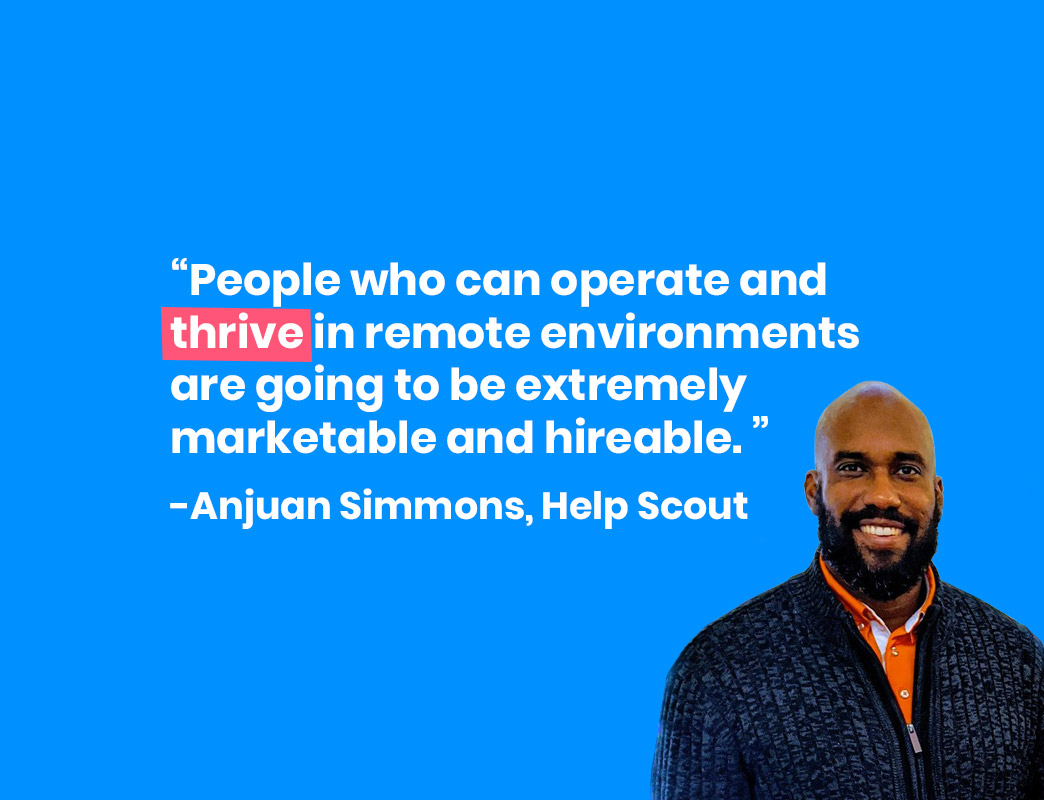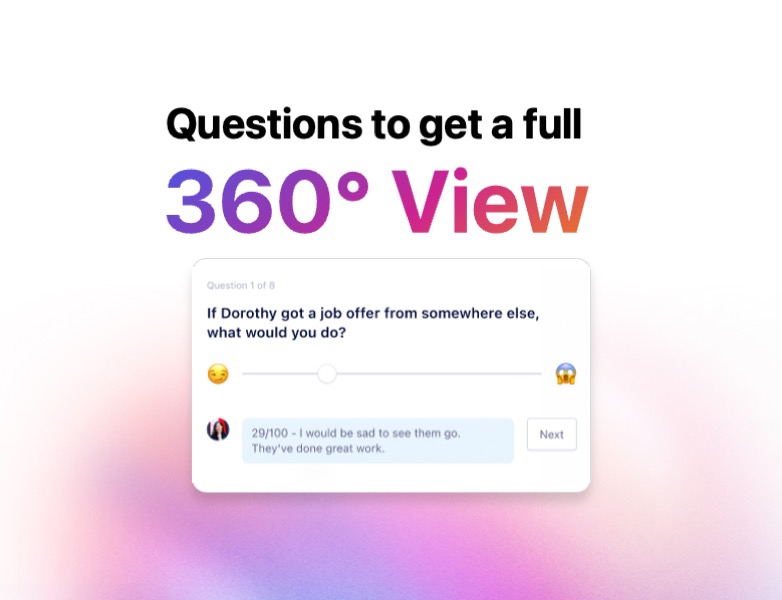Remote Leaders: Anjuan Simmons of Help Scout and how remote work opens up new talent pools
9 min read
Meet Anjuan Simmons: Consultant, Speaker, Author and Engineering Coach at Help Scout. Anjuan started his remote journey long before joining the fully distributed team at Help Scout and we caught up with him to learn more about his remote journey and how he coaches his team.
Fast facts about Anjuan
-
Engineering Coach at Help Scout
-
Manages a team of 6 engineers
- Based out of Houston, Texas
How long have you worked remotely?
I started with Help Scout a little more than six months ago, but I first started working remotely five years ago. I’ve had a mix of remote and co-located roles over the years, and I’m glad to be back on the remote side!
How many direct reports do you have?
I have six engineers: Three backend PHP developers, two frontend javascript developers, and one test engineer.
Where are you and your team located?
Help Scout has people all over the world, but I’m based in Houston, Texas with team members located across North America in Toronto, Louisville, NYC and Portland. We have a player-coach model so, on my team, the ratio of players to coaches is 6:1. There’s been a lot of research around how many employees a manager should be managing at once, and the ideal ratio is no more than 8 players to a coach. That ratio allows you to optimize the work that gets done and optimize the team, and I’m well under the limit.
What’s in your tech stack?
We use Zoom for video chat, Slack for messaging, Jira for work management, the Google suite, and all of our formal documentation lives in two tools: Dropbox Paper and Slab. In general, Dropbox Paper works for informal documents, while we publish official documentation to Slab. Our personal notes are in Dropbox Paper as well.
I do want to provide one caution regarding thinking about tools for a remote team. Tools can only take you so far, and they’re not a replacement for hiring great people. No tool will make a low performing team better. You have to focus on building a great team, and that starts with being a great place to work.
What’s your biggest challenge working remotely?
Communication is the biggest challenge of working remotely. When you work in one physical location, you can bump into people and have conversations, whereas with remote communication you have to be very intentional with what’s happening with each other and with the work. We have a lot of structure to amplify both formal and informal communication. We plan our work in development cycles consisting of 4 sprints with each sprint lasting two weeks. We plan and talk about our work in these time boxes (sprints and development cycles).
With regards to how we work with each other, there’s something we do at Help Scout called a Fika, which is a Swedish word for “get coffee.” In Sweden, there’s a practice of taking a break, getting coffee and catching up with someone while eating something pleasant like a pastry. We regularly have Fikas with each other both within engineering and across departments. I have roughly one Fika a week where I hop on a Zoom with other folks at Help Scout, and we talk about our lives. Fikas have been a great way to create cohesion, cement personal connections and improve communication. Our efforts to structure and support communication bridge the gaps inherent in working remotely and make sure we’re all singing from the same sheet of music.
What’s the biggest advantage of working remotely?
The biggest advantage is the ability to find talent and work with people who were hired based on what they bring to the table and not because they live in the same geographic location. Remote work allows companies to find industry leading skills, experience, and business insights about the technology industry. So, most companies can only hire people within a certain distance from an office. With remote work, people can bring the fullness of who they are, regardless of where they live.
Where do you actually work?
I work in my home office, usually at my standing desk. I thought about taking advantage of a company subsidized co-working space, but I get so much work done at home. At my last company, I was always the last person in my family to get home, but I’m now the one who is home more than anyone else!
How do you start your work day?
After I wake up, I walk a few steps into my home office and close the door. I take some water out of my mini-fridge, make some coffee, and lay on the couch to journal with my tablet and stylus. This simple 15-minute ritual is important because it helps me leave my personal world and transition into the world of work.
However, most people who start working remotely don’t realize that they no longer have the normal physical traditions involved in a commute. You no longer get into the car/train, listen to music or a podcast, and make the gradual mental preparations for work. You suddenly have a lot of time freed up at the start of the day, and it’s easy to just spring out of bed and start working. You can then blow through lunch and inadvertently work a lot longer than you did when you had to commute to work. So, if you’re new to working remotely, remember to create some kind of ritual at the beginning of your work day because this will help reduce the risk of burning out.
Would you ever go back to working on site?
It would be really hard because I love working at Help Scout. We’re doing interesting work and tackling cool challenges, so I don’t have any plans to work anywhere else. We’re not constrained by the co-located model of only being able to hire within a certain driving radius of the office. We can hire the best in class regardless of location, and that’s hugely important to me. It would have to be an extremely attractive offer for me to go back to working at a corporate office.
How did you handle the transition from being on site to remote?
Thankfully, I had a couple of weeks to transition from my previous employer. Help Scout provides a stipend for building out your office and desk space. So, I spent a lot of my transition time investing in my home office. I searched for and ordered a nice microphone, webcam, laptop stand, anti-fatigue mat, chair, lights, sofa, and other items to make sure I would be fully productive.
After that two week period ended, I entered the fantastic onboarding experience that Help Scout provides to every new employee. At the end of my transition period, I had the equipment and the knowledge to be successful!
What’s one piece of advice can you give to someone who is about to go fully remote?
If you’re going fully remote, invest early in building your personal brand. While I don’t fully like the term “personal brand”, it simply means the things people say about you when you’re not in the room.
So, learn the job, get to know your co-workers, and bring your best self to work every day. Schedule Fikas often and early, and, if your organization doesn’t do Fikas, then introduce the tradition! Also, really get to know your team, but branch outside of your immediate coworkers and form relationships outside of your department.
Everyone is going to judge you by the work that you do, but people will be truly moved by how you make them feel. So, build a reputation for having a positive attitude! Make daily investments in making sure people view interactions with you as enjoyable experiences that always leave them feeling better than before they talked with you.
Do you feel like being remote hinders your career growth in any way?
No, in fact I think it has expanded my career growth. Working remotely will only become more common. People who can operate and thrive in remote environments are going to be extremely marketable and hireable.
For companies, the substantial investment you’re making in office space and utilities all goes away with the remote model. You can redirect that financial commitment to optimizing your hiring practices to find the best talent regardless of location.
Working remotely was difficult a few years ago due to the immaturity of the tools. However, there are now commonly used tech stacks to enable remote workers and proven practices to optimize their performance.
On the topic of loneliness, do you ever feel lonely or isolated working remotely? If so, how do you combat it?
No, I don’t feel lonely or isolated for a couple of reasons. First, I’m a classic introvert. I love people, but I need lots of silence and solitude to recharge myself. Second, Help Scout provides so many ways to connect to others. I really enjoy working with my team, and we have daily meetings, Fikas, and a retreat twice a year where we fly everyone to the same physical location. We have great tools and a great culture, but investing in being in the same location is essential. We’ve found that spending time together, even just twice a year, helps us avoid the feeling of isolation. We know that in any given six month period, we’re going to meet each other and the awesome new people who have joined us.
What was your reason for working remotely in the first place?
I didn’t choose to work remotely this time around. I found an amazing company that happens to work remotely, and that’s why I’m here at Help Scout.
Learn more from remote leaders like Anjuan:
- Remote Leaders: Why GitLab’s Head of Remote “unchained from a life of commuting”
- Remote Leaders: Dana Doswell of Sidepart on why habit building is the key to remote work
- Remote Leaders: Marcus Wermuth of Buffer on overcommunication and isolation
- Remote Leaders: Brian Thomas, VP Product at Customer.io on how being remote has made him a better employee


